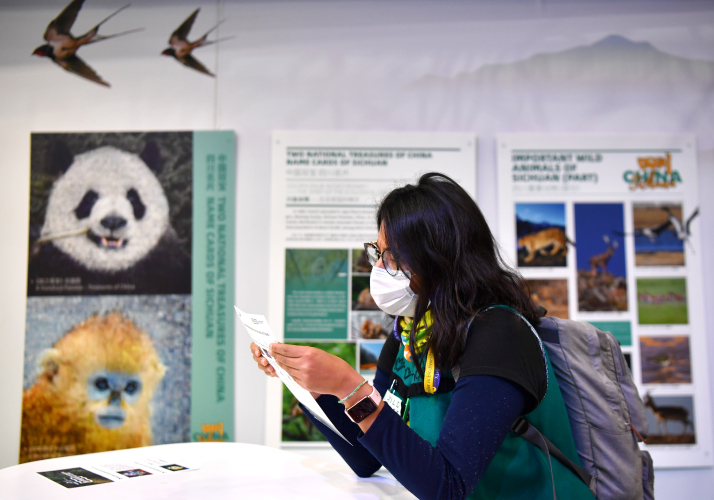| Voice |
| Green gains | |
|
|
 Dimitri de Boer, chief representative of London-headquartered environmental law organization ClientEarth in China (ZHANG WEI)
Dimitri de Boer, chief representative of London-headquartered environmental law organization ClientEarth in China, has been supporting intergovernmental cooperation on environmental and ecological protection between China and European countries. He is also team leader of the EU-China Environment Project, which is funded by the EU. In a recent exclusive interview with Beijing Review reporter Li Xiaoyang, he shared his views on China's efforts to improve biodiversity and curb pollution, as well as China-Europe green cooperation. Edited excerpts from their conversation follow: Beijing Review: How do you view the results of China's biodiversity protection and efforts targeting environmental pollution in recent years? Dimitri de Boer: I've worked in China for 20 years for ClientEarth. When I first came to Beijing in 2002, the sky was often hazy. In the following years, an increasing number of people became concerned about air quality issues. Since 2013, the government has introduced more measures, including the disclosure of air quality data and new legislation, to tackle the problem. In only one decade, the air pollution level has reduced by more than half, and we can really see the results now. China has a saying: "Green is gold." China was president of the 15th Meeting of the Conference of the Parties to the Convention on Biological Diversity (COP15) last year. One of China's impressive efforts on biodiversity protection is the ban on fishing in the Yangtze River. In the past decades, some species have gone extinct in the river due to pollution and overfishing. The fishing ban is enforced well, and it shows how quickly fish stocks can recover there. River dolphins are now returning to some of the cities along the Yangtze. China has also used its ecological conservation redline policy to designate more than 30 percent of its land for natural protection. Those areas were selected based on a thorough scientific assessment of which areas have the most biodiversity, provide ecosystem services, and contribute to disaster risk reduction. It has made extensive use of satellites to monitor the actual protection of the redline areas. Many countries may have protected areas, but sometimes they are only protected on paper and the real level of protection is weak. In China, a lot of environmental laws have been revised since 2014. In 2015, China started to have environmental courts with judges specializing in the field, which have been very effective. The implementation of environment-related laws is one major shift that I've seen in China in the last couple of years. A few years ago, wildlife parts like ivory, rhino horns and tiger bones were consumed in China and other countries as wild animals were being poached. China's prosecutors teamed up with [Chinese] customs to crack down on illegal wildlife trade. As a result, the wildlife smuggling declined significantly, as the risk of getting caught became much higher. That has had global consequences, which are important for biodiversity protection.  An exhibition on China's biodiversity during the Second Phase of the 15th Meeting of the Conference of the Parties to the UN Convention on Biological Diversity in Montreal, Canada, on December 11, 2022 (XINHUA)
What are the ecological and environmental challenges facing the world, especially China, and what are the solutions? Since 1970, more than half of the world's nature has disappeared. This is a very real threat. Biodiversity has also seen a rapid decline over the past five decades. In 2022, some countries experienced the worst heat waves ever recorded. We are seeing more and more evidence that it's possible to grow the economy and to have a solid livelihood without destroying the environment these days. To sustain the trend, part of the solution may lie in increasing funds that go to natural protection and finding green business opportunities. For China, there's a long way to go before it can achieve the carbon peaking and neutrality goals before 2030 and 2060, respectively. The main undertaking should zoom in on the biggest sources of emissions, such as the power sector. China needs to up investment in a low-carbon power system, which needs a flexible and interconnected power grid, as well as more power storage. China is also ramping up cooperation with other countries on improving their use of renewable energy. There will be great opportunities in the sector in the next couple of years. China's carbon peaking and neutrality goals send a clear signal to businesses, people and governments of where to go from here. China's progress in the green transition gives tremendous confidence around the world, especially among developing countries. How have China and European countries cooperated on green development? The relations between Europe and China on environment and climate are positive and have been strong over the past years. During French President Emmanuel Macron's visit to China in April, both countries highlighted many environmental issues in their joint statements. Such exchanges can lead to win-win results, and help avoid policies which may have negative impacts on one side. Having similar policy frameworks also helps to provide a more level playing field. Countries need a common understanding and mutual trust to address global challenges. Over the past 50 years, the world has lost a lot of its forest cover, including many rainforests. The biggest driver here has been agricultural conversion. In the joint statements between Chinese President Xi Jinping and Macron, and between Xi and Brazilian President Luiz Inácio Lula da Silva, this issue is specifically highlighted, including the link between deforestation and trade. It is an area where producing and consuming countries could better work together to reduce deforestation around the world. China and European countries are also improving cooperation on green finance. Recently, the two sides have been trying to boost economic growth. In Europe, all funds for economic stimulus should support broader policy goals, and that means they must be green and climate-friendly. China is also making efforts to channel more economic stimulus funds into the low-carbon and green sectors, which are strategically good in the long run. Under the Belt and Road Initiative (BRI), which China proposed to boost connectivity along and beyond the ancient Silk Road routes, China is upping investment in greener programs in participating countries. What is your observation? Many countries along the Belt and Road routes are still developing. In the past, there wasn't always a focus on environmental protection in BRI projects. In 2021, China announced it would not be building any new coal-fired power projects overseas. China's focus has shifted to supporting other developing countries in their green and low-carbon power systems. Previously, many people assumed that developing countries would need to pollute to develop their economy. But this perception has changed. Many countries are starting to understand that green development and low-carbon energy systems based on renewable resources provide strategic independence. It means that countries can supply their own power and do not have to rely on imports. ClientEarth has worked with the International Belt and Road Green Development Coalition under the Ministry of Ecology and Environment of China to study ways to make the initiative green. Bad investments have become fewer and fewer, but the big priority now should be to develop more green investment projects. This means growing the pipeline of green projects, which requires long-term planning. How has Chinese public opinion on greener living changed, according to your observations? Green lifestyles have become trendy in China. In the beginning, people may have been just concerned about their own health. Now that kind of thinking has evolved into a consideration of the environmental impacts of daily activities. I'm seeing more and more Chinese people starting to think along those lines. Public awareness on environmental issues has definitely improved. Green labels on products would help people make better consumption decisions. An even bigger opportunity is price signals. If certain polluting things become slightly more expensive, that may prove very helpful. The authorities could assess a product's carbon emissions or water and energy consumption, and then use the revenue from taxation or carbon pricing schemes to support vulnerable groups. Governments can do many things to encourage green consumption. Over time, pricing should become an important part of that. As many people today consume online, goods come in different packaging. E-commerce businesses have an important role in the green use of packaging, given they are the platforms that link consumers with shops—and the whole logistics chain. Consumers should also get more choices in terms of sustainable packaging. Copyedited by Elsbeth van Paridon Comments to lixiaoyang@cicgamericas.com |
|
||||||||||||||||||||||||||||
|
